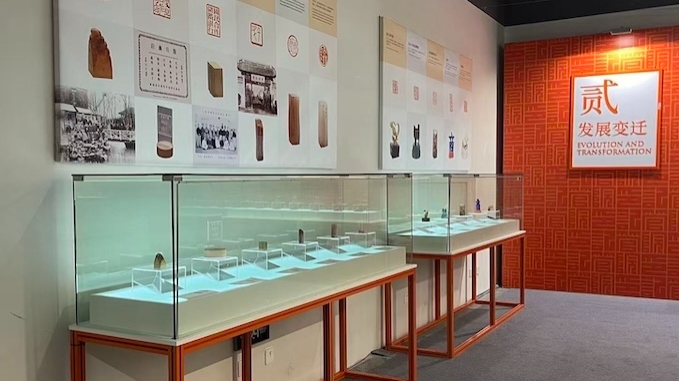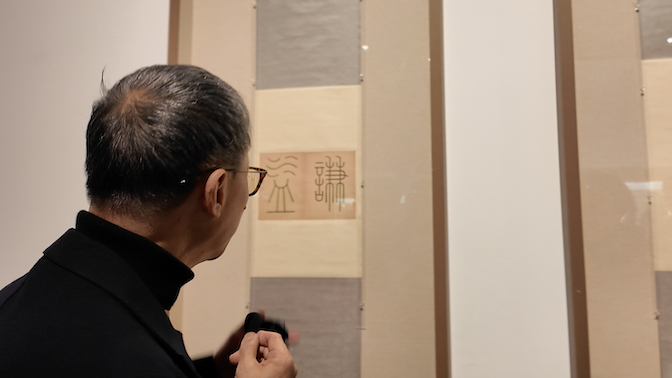
The Paper learned that the School of Management at Fudan University recently held an exhibition entitled "Imprints of the School of Management: A Public Seal Carving Exhibition Commemorating the 40th Anniversary of the Re-establishment of the School of Management at Fudan University" at the Zhengli Campus. The exhibition uses "public seal carving" as a medium to present the 40-year development history of Fudan's School of Business History and Management.
The organizers stated that the original intention of popular seal carving, evolving from a "niche hobby" to a "popular art," is to "protect Chinese characters, promote Chinese characters, and bring the art of seal carving to the masses." This exhibition demonstrates that "popular seal carving," characterized by innovative materials, digital processes, and cross-disciplinary approaches, is gradually entering the lives of the public. Seal carving is no longer an elite art as it once was, but rather a cultural activity that everyone can participate in and experience.

According to the organizers, the public seal engraving movement aims to break through traditional boundaries, gradually moving from professional circles to everyday life, injecting cross-disciplinary vitality into seals through innovative materials, digital processes, and new media dissemination. The "Seal Engravings of Fudan University School of Management: Pioneering Innovation and Transformation – Public Seal Engraving Exhibition Commemorating the 40th Anniversary of the Re-establishment of Fudan School of Management" currently on display at the Zhengli Campus of Fudan University's School of Management is a typical example.

Exhibition site
Expressing Sentiments Through Seals: Presenting the History of Fudan Business School
This exhibition marks the first time the school has used the creative form of seal carving to revisit its history, telling the collective memory and humanistic spirit of Fudan School of Management through seal carving. The exhibition, titled "Imprints of the School of Management: Pioneering Innovation and Transformation," includes six sections: "The Founding of Business Studies," "Development and Change," "Pioneering Innovation and Transformation," "Seeking Truth and Excellence," "Remembrance and Gratitude," and "I am a Fudan Person."

Exhibition boards
In 1917, Fudan University established its business school, becoming one of the earliest universities in my country to establish a business administration education system. In the display case, the "Early Establishment of Business School" exhibition area features a seal with the name "Fudan Business School" hand-carved from bamboo root, which not only reflects the historical context of the time but also symbolizes the initial establishment and budding of business school.

Fudan Business School
On the opposite display case are the graduation certificates of Xu Yimao, an alumnus of Fudan University, which were stamped and signed by former Fudan University President Li Denghui; as well as Xu Yimao's textbook "Auditing" and his handwritten diaries. It is understood that Xu Yimao was admitted to the Department of Accounting, Business School of Fudan University in 1925. These documents were preserved and donated by his great-grandson, Mr. Xu Zhihong.

Graduation certificate of Xu Yimao, an alumnus of Fudan University

The textbook "Auditing" compiled by Xu Yimao, an alumnus of Fudan University.
In 1929, the Business School of Fudan University was established. At that time, the Business School comprised the Departments of General Commerce, Banking, Accounting, International Trade, and Business Administration. In the display case, visitors can see a seal bearing the words "Fudan University Business School" hand-carved from stone. Next to it is a set of seals made using the internal engraving technique in crystal, featuring group photos of graduates from the five departments.
In 1952, with the newly founded People's Republic of China in dire need of reconstruction, the 1952 graduating class of the Department of Business Administration at Fudan University, as the first batch of university graduates trained after the founding of the PRC, went to various parts of the country to devote themselves to economic construction. Fudan students participated in the establishment of the First Automobile Works. In 1958, the first domestically developed "Dongfeng" brand sedan and the first domestically developed "Hongqi" brand luxury sedan were successfully trial-produced. In the display case, the design of the "First Batch of Graduates of New China" stamp is based on the prototype model of the "Dongfeng" sedan, with the side inscription "In 1952, the 1952 graduates of the Department of Business Administration went to the front line of the country's economic construction"; next to it, the design of the "Dedicated to the Economic Construction of New China" stamp is based on the prototype model of the "Hongqi CA770" sedan successfully developed in 1965.

At the exhibition, the seal with the inscription "Dedicate yourself to the economic construction of New China" is designed based on the prototype model of the "Hongqi CA770" car, which was successfully developed in 1965.
In 1985, the School of Management at Fudan University was re-established, with Professor Zheng Shaolian serving as its first dean. In the "Innovation and Transformation" exhibition area, there is a seal bearing the inscription "School of Management, Fudan University," modeled after the name stone at the entrance of the school's Guoshun campus.
In the "Remembrance and Gratitude" exhibition area, there is a set of seals based on photos of representative figures from Fudan University's business school era, with portrait designs by painter Liu Shuang. The seals depict Cai Jingping, the first dean of the business school; Li Quanshi, the first dean of Fudan Business School; Xie Lin, China's first certified public accountant; Li Binghuan, the second dean of Fudan Business School; and teachers Xu Zirong and Ma Jiahua.
The seals on display were mostly created by Fudan University faculty, students, alumni, and seal engraving enthusiasts. For example, the theme seal consisting of two seals, "Imprints of the School of Management: Pioneering Innovation and Transformation," was designed by Lu Xiongwen, Dean of the School of Management at Fudan University. Through a dialogue between tradition and modernity, it presents the school's spirit of innovation in inheritance and development in innovation.

The seal "Imprint of the School of Management" incorporates the movable type engraving style of the School of Management's "Eternal Imprint" donation wall.

The seal, "Pioneering Innovation and Leading Change," is designed in the style of the college's administrative campus buildings.
Jin Jiaxi, an alumnus of the Fudan MPAcc program, designed the "Fudan MPAcc" seal using a unique "bird-and-insect seal script" font. Jin Jiaxi stated, "Incorporating English letters into the design is both a challenge and an innovation. The design follows traditional character formation rules, breaking through tradition while adhering to the path of 'maintaining the orthodox'." The "All-Member Mentorship System" seal is inspired by the popular mascot "Guan Xiaoxiong" from the School of Management, and its design was participated in by undergraduate student Chen Jianzhi. The "Master's and Doctoral" seal was designed by student Wang Fujing, with the strokes of the characters "Master's and Doctoral" connected to symbolize the "continuous study" system.

"Fudan MPAcc"

"Master's and Doctoral" seals
Fudan University's School of Management currently comprises eight departments: Finance and Accounting, Applied Economics, Management Science, Accounting, Business Administration, Marketing, Statistics and Data Science, and Information Management and Business Intelligence. In the "Seeking Truth and Excellence" exhibition area, visitors can see the unique seals of each department. For example, the Accounting Department's seal pays homage to tradition, featuring a traditional abacus design. The Information Management and Business Intelligence Department's seal, "Information, Intelligence, and Far-Reaching Vision," incorporates core elements of databases, binary systems, decision trees, and neural networks, and also includes a QR code that visitors can scan to learn more about the department.

Fudan University School of Business

"Faith, Wisdom, Action, and Far-Reaching Vision" Seal
New materials and new concepts are integrated into seal carving.
It is understood that the first person to propose the concept of popular seal carving was Li Lanqing, an alumnus of Fudan University. He hoped that seal carving would break through the traditional barrier of being a "niche hobby" and encourage everyone to participate, so that the art of seal carving could take root in life.
The organizers told reporters that, through years of practice and development, the main components and specific content of popular seal carving are "Six Sayings," "Six Transformations," and "Six Advancements," aiming to illustrate the modernization process and popularization of seal carving. The "Six Sayings" are "Seal art expresses beauty, aspirations, emotions, interests, events, and history," encompassing artistic appreciation and aesthetic pursuit, as well as emotional expression, creative expression, and historical narration. The "Six Transformations" include "Thematic creation, digital design, diversified materials, intelligent creation, networked promotion, and life-oriented application." This emphasizes the transformation of seal carving's function, moving it away from being a mere supporting element to calligraphy, painting, and poetry, and making it independent and central to showcase contemporary themes, humanistic themes, and distinctive themes. "Diversification" breaks away from the traditional limitation of seal carving primarily using stone seals, introducing materials such as bamboo, wood, ceramics, and glass, and utilizing modern technology to incorporate hollow glass microspheres, optical fibers, carbon fiber, glass fiber, artificial graphite, and high-tech synthetics as new seal materials. Meanwhile, in recent years, more advanced, convenient, and efficient digital application software for creative design and new intelligent seal engraving machines have solved the problem of knife skills required for engraving.

The "Science and Education Revitalize the Nation" seal is made of hollow glass microspheres.
The seals presented in this exhibition differ from traditional seals in both their materials and designs. From traditional materials to photosensitive resin and glass microbeads, from hand-engraving to laser engraving, 3D printing, and color printing, many exhibits break traditional boundaries, showcasing their unique creativity. Many visitors commented that the materials and designs of many seals were very novel and technologically advanced.

The "Opening Ceremony of the Legislative Yuan Campus" stamp is made from recycled colored balloon rubber.
For example, the seals in the display case, including the "College Motto Seal," are made of hollow glass microspheres. This micron-sized, lightweight material, commonly known as "industrial flour," is widely used in the petroleum industry, aerospace, and 5G communications. Due to its affordability and high plasticity, the material cost is much lower than that of traditional stones. Furthermore, with the help of new technologies, Fudan University's old gate, the school motto wall, and iconic buildings from various cities where the university has partnered with foreign institutions have all been transformed into miniature landscapes.
At the previous symposium on "Prospering New Popular Art: The Contemporary Value and Future Vision of Popular Seal Carving," scholars and experts discussed how technological innovation is not a negation of tradition, but rather an expansion of creative possibilities through the integration of "technology + art." Huang Wei, a member of the editorial team of "Eighteen Lectures on Popular Seal Carving," noted that in the past, creators typically hand-designed seal drafts on paper with a brush, often requiring multiple revisions to achieve the desired effect, which was time-consuming and laborious. Now, with the help of computer software, adjustments can be made only to the parts that need optimization, greatly improving the efficiency and accuracy of revisions.
"Seal culture has never been far from the lives of Chinese people, and it has the potential to become a new creative and artistic medium, playing a greater role in the integration of culture, tourism, commerce, sports, and exhibitions," said Zhou Weitao, a member of the Presidium of the China Electric Power Calligraphers Association, deputy director of the Seal Carving Committee, and head of the editorial team of "Eighteen Lectures on Popular Seal Carving".
This exhibition will run until January 31, 2026.


